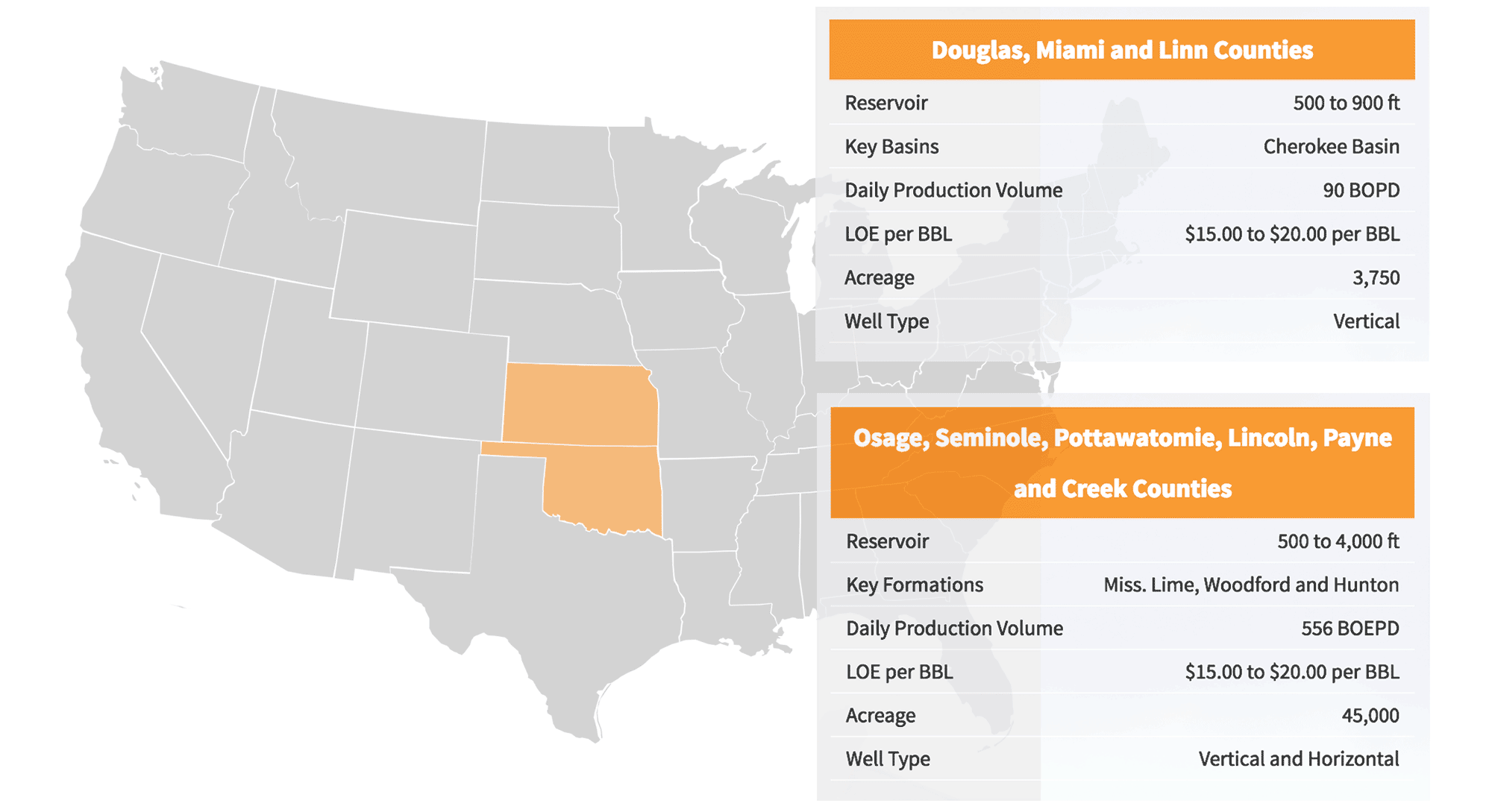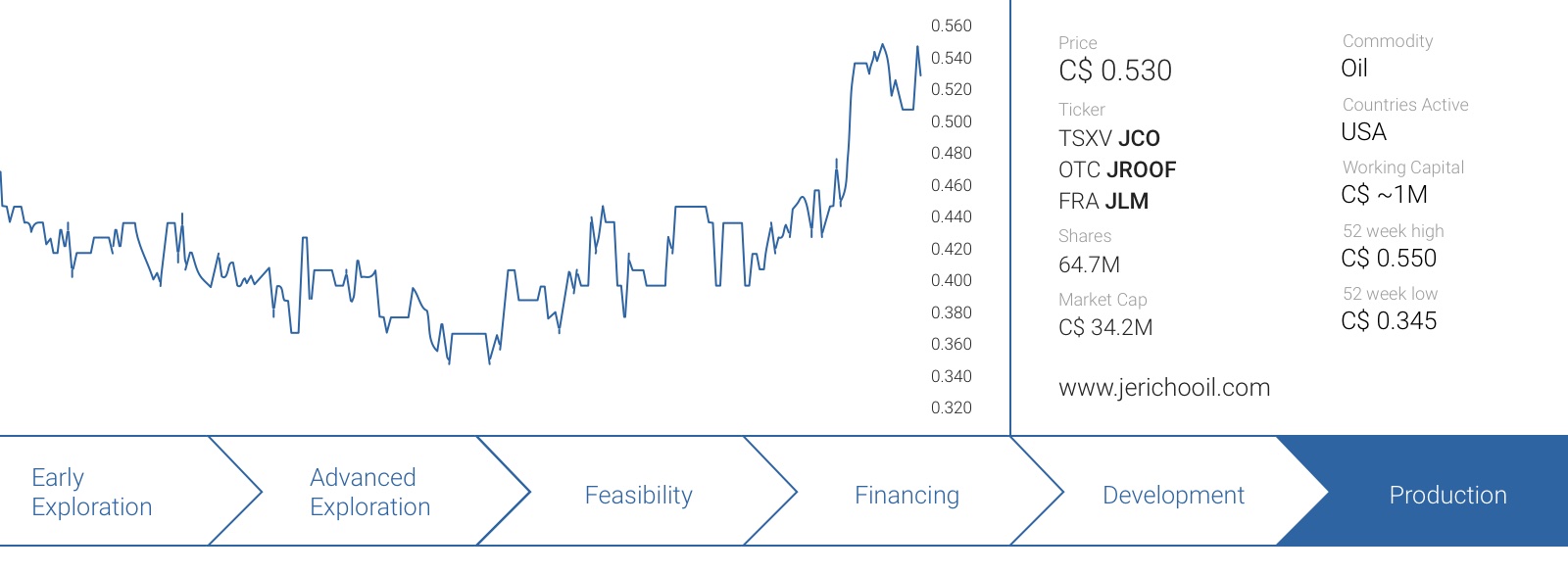We wanted to gain some exposure to the oil markets earlier this year (and actually already late last year), and after several discussions with CEO Allen Wilson and Director Corporate Communications Adam Rabiner, we were very confident Jericho Oil (JCO.V) has what it takes to be successful in this sector.
The company’s modus operandi was quite simple, it tries to find producing oil assets in the Midwest region of the USA (with a specific focus on Oklahoma) and buys those assets below fair value, so the company will benefit from an increase in the oil price.
Explaining the updated reserve report
Every oil and gas company needs to file its reserve reports with the exchange and the regulators, and in Canada the NI51-101 technical report could (and should) be seen as the little brother or sister of the NI43-101 report in the mining sector.
Reserves Statement (PDF) Annual Financials (PDF)
These updated reserve reports are always a very interesting read as it allows you to try to determine the fair value of the oil and gas properties and the attributable net value to the shareholders of the company. In Jericho’s case, the consultants have provided some sort of sensitivity analysis showing how the present value of the cash flows (on a pre-tax level) changes depending on the used discount rate.
So, using a discount rate of 10%, the total value of the reserves in the proved category is approximately US$15.8M, and if you’d include the probable reserves as well, the fair value right now is US$17.2M (C$22M).
Keep in mind this is based on a higher oil price in the future; and the company’s consultants used Sproule’s price deck which assumes an oil price of $45/barrel in 2016, increasing to $80/barrel in 2019. That’s quite optimistic but not impossible, and using these oil prices are pretty much a standard practice in the sector.
It’s also important to notice the total value of the proved and developed reserves was now $14.8M, up from $3.9M last year. That’s a 277% increase in the value of these barrels and that’s an excellent achievement considering the oil prices used for the calculation are now lower than a year ago. By seeing a $10.8M increase in the PV-10, Jericho Oil has now indeed proven its acquisitions are definitely adding value. The entire $10.8M increase was caused by the company’s acquisitions which costed Jericho $6.29M. So, long story short, Jericho paid $6.3M for assets that have a value of $10.8M on a PV-10 basis, using a standard price deck for the oil prices. And that’s pretty nice!

Jericho is now trading above its PV10-level, is this a signal to sell stock?
As we don’t want to bore you too much with just throwing some million dollar numbers out here, we have compiled a table for you which shows the fair value per share based on the official PV-calculations, using an USD/CAD exchange rate of 1.28.
[table caption=”Fair value per share based on official PV-calculations” colalign=”left|left|left”]
Discount Rate;Proved Reserves Value in Canadian Dollar;PV/share (in C$)
PV 15;C$15.41M;0.2286
PV 10;C$20.19M;0.3121
PV 5;C$28.49M;0.4403
PV 0;C$45.5M;0.7003
[/table]
Indeed, the company now has a market capitalization higher than the PV10 value of its assets (which usually is the basis to be able to compare apples with apples).
So, yes, the current share price of C$0.53 is a bit higher than the current fair value based on the PV10 calculation of the proved and probable reserves, but that’s not necessarily a reason to sell. First of all, The oil price might increase faster and reach a higher level than originally anticipated by the consultants, providing additional leverage to the share price. An average oil price of $70 in 2017 (rather than $60) will increase the undiscounted cash flow by a few hundred thousand dollars per year and the total discount factor will be lower.
Secondly, a discount rate of 10% is rather high, especially in the current low-yield environment. A discount rate should be seen as the combination of a risk-free interest rate and a risk premium. And as the current risk-free interest rate (we use the 10Y T-Note as risk-free interest rate), the risk premium would be approximately 8%. That’s very high for a company with a proven production profile and a single-digit decline rate. We wouldn’t recommend to use a discount rate of 5%, but a fair discount rate would be somewhere in between 5% and 10%. And indeed, you notice the fair value of the PV5% calculation is almost 35% higher than the fair value of the PV10% calculation.
And finally, and this is the most important argument; Jericho’s management team knows how to pick up assets on the cheap. As we explained in the previous paragraph, it paid just US$6.3M for properties that have a total value of in excess of $10M and as Jericho’s cash flow is now increasing, we would actually expect to see more accretive deals this year, which means the valuation gap could be closed overnight.
Why was the revenue in 2015 lower compared to 2014, despite the production increase?
It’s important to emphasize every barrel of oil Jericho is pumping out of the ground is profitable. Due to the exceptionally low decline rate (less than 10%), the company is able to keep the production rate relatively stable without having to invest a lot of cash on capital expenditures. Based on the current oil price on the spot markets, Jericho is generating $20-22/barrel in operating cash flow.
We were however a little bit surprised when we saw the total revenue in 2015 was more than 10% lower than the revenue in 2014, even though Jericho was supposed to have sold more oil (considering the partnership was able to fourfold the production rate in Q4 of last year, we were expecting a substantial bump in the Q4 revenue).
That didn’t happen, so we had a chat with Allen Wilson, Jericho’s CEO, and he explained the auditors weren’t comfortable to book the revenue as ‘revenue’, as they were unable to establish a sufficient level of trust in the data that was available. Keep in mind the seller of the largest project, PostRock Energy, went bankrupt a little while ago, so the auditors wanted to play it safe and instead of allowing Jericho to report the oil sales as revenue, it forced the company to book it as a ‘gain on bargain purchase’ which is being clarified in Note 10 of the financial statements. That’s another reason why the reserve report was so important, as the company’s auditors based their valuations on this reserve report.
So even though Jericho’s cash flow statements are showing a negative operating cash flow, this situation should change from the current quarter on and the attributable oil production should now indeed be reported as revenue from now on.
More bankruptcies in the sector means more available properties
Jericho obviously still is in a growth mode, and we expect the company to be able to acquire more oil-producing properties. We’re still waiting for the acquisition of the remaining 25% of the PostRock deal to close (Jericho has an option to acquire an additional 25% for approximately C$4M), but we’re pretty sure the company is targeting other deals as well.
And perhaps the recent bankruptcy procedure initiated by Ultra Petroleum (UPL) and Midstates Petroleum might result in an increase of oil producing properties that are being put up for sale. Ultra had some gas assets and we don’t think Jericho would be too interested in natural gas right now, but Midstates does have producing oilfields in Oklahoma, and some of the company’s assets could be a nice fit for Jericho Oil.
Conclusion
This is not your average oil company. Yes, Jericho is currently trading slightly above its PV10 valuation, but this gap could be closed very easily as the company’s management team has now proven it does know how to create additional value.
In 2016, the company will continue to focus on growth, and as more bankruptcies in the oil and gas space are looming around the corner, this might be the year for Jericho Oil, and we expect the company’s exit rate to be higher than the current production rate of ~260barrels per day – increasing to 360 once the option to acquire an additional 25% of the Central Oklahoma asset closes.
Disclosure: Jericho Oil is a sponsoring company, we hold a long position. Please read the disclaimer





